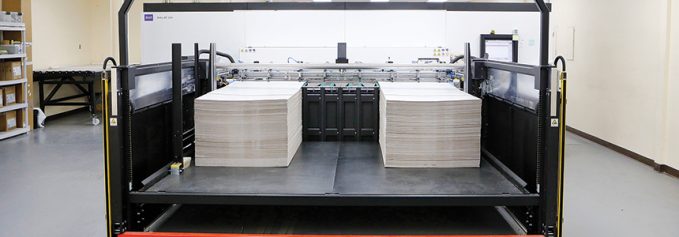
By Cassandra Balentine
Working with corrugated substrates takes experience and skill. The media is porous, flexible, and rigid at the same time. However, those that have mastered working with this media produce impressive packaging and display work.
Valley Container is a full-service corrugated sheet plant with production capabilities including pads, die cuts, cartons, and warehousing services as well as design and manufacturing of high-end point of purchase (POP) graphics.
Above: Valley Container is a full-service corrugated sheet plant with production capabilities including pads, die cuts, cartons, and warehousing services as well as design and manufacturing of high-end POP graphics with the help of its Durst Delta WT 250 corrugated printer.
Corrugated Capacity
The company started out as a brown box provider. Headquartered in Bridgeport, CT, it employs a staff of 67 and covers 87,000 square feet of production space.
Robert Niedermeier, GM, Valley Container, explains that the company was established by his father and his father’s business partner in 1969. The next generation of the two families has since taken the reigns and continues to expand and evolve.
From the late 1960s through the 1980s the company thrived off its original brown box services. However, those golden years began to transition when new regulations started coming out and U.S. manufacturing was lost in favor of China, India, and Mexico.
Realizing the shift, Valley Container decided to enter graphics. In the 1980s it began printing audio cassettes and CD displays along with center aisle signage. “We started growing that business and divesting the brown box focus into the graphics side,” shares Niedermeier.
Along the way it continued to grow its equipment list, adding printing and finishing capabilities to cover everything from full labels to direct printing of oversized standees to trailer load quantities. Today the company works with corrugated, paperboard, honeycomb, and foam materials to produce shipping boxes, protective packaging, stock boxes, POP displays, partitions, boxes, flutes, panels, and pallets.
Road to Expansion
In addition to corrugated and paperboard, Valley Container designs and manufactures multi-color POP displays. While its primary business relies on analog production equipment, it continuously searches for solutions to support its evolving graphics operations.
In 2010, digital wide format printing technology was making a buzz in the packaging world. “Early machines were running ten to 20 sheets per hour, but we kind of laughed at it. The technology was coming along but it wasn’t quite there. I was conscious about wanting the latest development, but it had to measure against our needs. At that point there was nothing that really fit, nothing durable enough for our industries or conditions,” shares Niedermeier.
About five years later, he saw improvements when single-pass solutions became available. While these devices could hit industrial speeds, the quality wasn’t up to par. “I went and saw the machines, talked to operators. But at that time to run it at production speeds you would have to compromise some of the quality,” he admits.
So he kept an eye on the market and decided it would make the most sense to get into digital slowly and methodically. In 2017, Valley Container started its digital journey with the purchase of a used HP Inc. Scitex FB700 Industrial Printer. The UV flatbed device was installed in the design room and everyone was trained on how to use it. The team produced comps and samples, starting out with units of five all the way to 50. Soon it was running more, and in about a year and a half it was maxed out.
Now Valley Container had a taste for digital and experienced the flexibility themselves. Niedermeier knew he was ready to invest and set out in search of a device that could offer variable passes at production speeds. Accustom to water-based inks, the packaging provider wasn’t interested in UV.
The company narrowed down its search to solutions from HP and Durst Image Technology US, LLC. The print quality was similar, but what sealed the deal was the automated feeding unit offered by Durst—although the model was pricier.
“We’re all about automation and efficiency. We went back and fourth, but in the end we went with the Durst because of the feeding solution,” he explains. “We’re in a unique situation because we have our own sheet feeder and are part of a large feed feeder group. We can take orders exact to size and meet demands others cannot,” shares Niedermeier.
In 2019, the company installed a Durst Delta WT 250 corrugated printer. The Delta WT 250 prints flexographic to lithographic quality with odorless ink. Durst Water Technology (WT) is highly suited for a range of corrugated packaging and display applications. Durst WT inks are free of hazardous labeling and comply with the strictest health and safety regulations. The system is equipped to produce POP displays and outer packaging economically in standard or custom sizes.
Currently, digital printing makes up a small, but growing percent of its workload. Niedermeier estimates it to be about five percent. The company continues its digital journey, most recently investing in an Esko digital cutting table.
Firing on All Cylinders
Valley Container celebrates an impressive history rooted in brown box manufacturing. However, the family-owned business looks to the future, making calculated investments in new technologies that can support its core business.
It entered digital carefully and strategically, dipping its toes in first and going all in on a machine to serve it for years to come.
Apr2021, Digital Output


